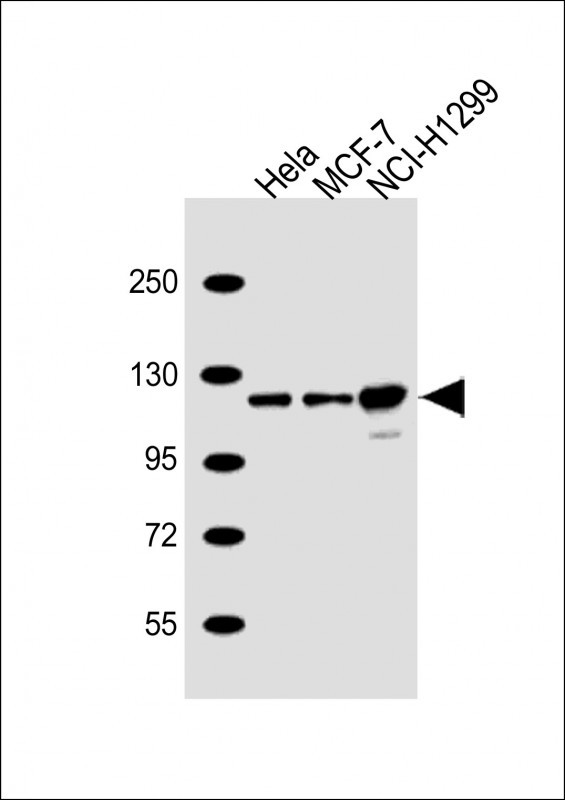PPP1R13L Antibody (N-Term)
Purified Rabbit Polyclonal Antibody (Pab)
- SPECIFICATION
- CITATIONS
- PROTOCOLS
- BACKGROUND

Application
| IF, WB |
|---|---|
| Primary Accession | Q8WUF5 |
| Reactivity | Human |
| Host | Rabbit |
| Clonality | Polyclonal |
| Calculated MW | H=89;M=89 KDa |
| Isotype | Rabbit IgG |
| Antigen Source | HUMAN |
| Gene ID | 10848 |
|---|---|
| Antigen Region | 134-166 aa |
| Other Names | RelA-associated inhibitor, Inhibitor of ASPP protein, Protein iASPP, NFkB-interacting protein 1, PPP1R13B-like protein, PPP1R13L, IASPP, NKIP1, PPP1R13BL, RAI |
| Dilution | IF~~1:25 WB~~1:2000 |
| Target/Specificity | This PPP1R13L antibody is generated from a rabbit immunized with a KLH conjugated synthetic peptide between 134-166 amino acids from human PPP1R13L. |
| Storage | Maintain refrigerated at 2-8°C for up to 2 weeks. For long term storage store at -20°C in small aliquots to prevent freeze-thaw cycles. |
| Precautions | PPP1R13L Antibody (N-Term) is for research use only and not for use in diagnostic or therapeutic procedures. |
| Name | PPP1R13L |
|---|---|
| Synonyms | IASPP, NKIP1, PPP1R13BL, RAI |
| Function | Regulator that plays a central role in regulation of apoptosis and transcription via its interaction with NF-kappa-B and p53/TP53 proteins. Blocks transcription of HIV-1 virus by inhibiting the action of both NF-kappa-B and SP1. Also inhibits p53/TP53 function, possibly by preventing the association between p53/TP53 and ASPP1 or ASPP2, and therefore suppressing the subsequent activation of apoptosis (PubMed:12524540). Is involved in NF-kappa-B dependent negative regulation of inflammatory response (PubMed:28069640). |
| Cellular Location | Cytoplasm. Nucleus Note=Predominantly cytoplasmic but also nuclear |
| Tissue Location | Highly expressed in heart, placenta and prostate. Weakly expressed in brain, liver, skeletal muscle, testis and peripheral blood leukocyte. |

Thousands of laboratories across the world have published research that depended on the performance of antibodies from Abcepta to advance their research. Check out links to articles that cite our products in major peer-reviewed journals, organized by research category.
info@abcepta.com, and receive a free "I Love Antibodies" mug.
Provided below are standard protocols that you may find useful for product applications.
Background
Regulator that plays a central role in regulation of apoptosis and transcription via its interaction with NF-kappa-B and p53/TP53 proteins. Blocks transcription of HIV-1 virus by inhibiting the action of both NF-kappa-B and SP1. Also inhibits p53/TP53 function, possibly by preventing the association between p53/TP53 and ASPP1 or ASPP2, and therefore suppressing the subsequent activation of apoptosis.
References
Slee E.A.,et al.Oncogene 23:9007-9016(2004).
Herron B.J.,et al.Submitted (DEC-2004) to the EMBL/GenBank/DDBJ databases.
Yang J.-P.,et al.J. Biol. Chem. 274:15662-15670(1999).
Takada N.,et al.J. Virol. 76:8019-8030(2002).
Bergamaschi D.,et al.Nat. Genet. 33:162-167(2003).
If you have used an Abcepta product and would like to share how it has performed, please click on the "Submit Review" button and provide the requested information. Our staff will examine and post your review and contact you if needed.
If you have any additional inquiries please email technical services at tech@abcepta.com.













 Foundational characteristics of cancer include proliferation, angiogenesis, migration, evasion of apoptosis, and cellular immortality. Find key markers for these cellular processes and antibodies to detect them.
Foundational characteristics of cancer include proliferation, angiogenesis, migration, evasion of apoptosis, and cellular immortality. Find key markers for these cellular processes and antibodies to detect them. The SUMOplot™ Analysis Program predicts and scores sumoylation sites in your protein. SUMOylation is a post-translational modification involved in various cellular processes, such as nuclear-cytosolic transport, transcriptional regulation, apoptosis, protein stability, response to stress, and progression through the cell cycle.
The SUMOplot™ Analysis Program predicts and scores sumoylation sites in your protein. SUMOylation is a post-translational modification involved in various cellular processes, such as nuclear-cytosolic transport, transcriptional regulation, apoptosis, protein stability, response to stress, and progression through the cell cycle. The Autophagy Receptor Motif Plotter predicts and scores autophagy receptor binding sites in your protein. Identifying proteins connected to this pathway is critical to understanding the role of autophagy in physiological as well as pathological processes such as development, differentiation, neurodegenerative diseases, stress, infection, and cancer.
The Autophagy Receptor Motif Plotter predicts and scores autophagy receptor binding sites in your protein. Identifying proteins connected to this pathway is critical to understanding the role of autophagy in physiological as well as pathological processes such as development, differentiation, neurodegenerative diseases, stress, infection, and cancer.



